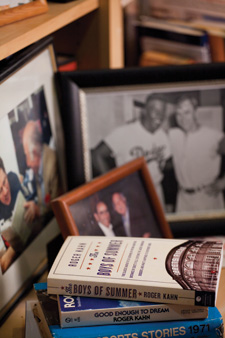alumni profile
The Man of Summer
Roger Kahn / ARTS ’48
by Sally Lauckner / GSAS ’10
Dubbed the dean of American sportswriters, Roger Kahn began reporting on baseball and the Brooklyn Dodgers in 1952 for the New York Herald Tribune. He later wrote about sports for Newsweek, Time, and Esquire, authored 20 books, and owned a Class-A minor league team, the Utica Blue Sox, which he helped steer to the 1983 New York-Penn League title. But it was his 1972 memoir, The Boys of Summer, that solidified his place in baseball history. The seminal text, which has sold more than three million copies, alternates between Kahn’s Brooklyn childhood and the Dodgers’ path to victory in the 1955 World Series. Sports Illustrated called it “the best baseball book ever written,” but Kahn insists, “I wasn’t trying to write a baseball book, I was writing a book about the passage of time and what it does to people.”
Now living in Stone Ridge, New York, with wife Katharine, Kahn, 83, talked to NYU Alumni Magazine about the current state of baseball and his early days covering the sport.
What are the biggest changes that baseball has undergone since 1952?
Money. There was a fine Dodgers pitcher, Carl Erskine, who struck out 14 Yankees in the 1953 World Series, and he earned $30,000. Back then the ballplayer worried about what he would do when his playing days were over. Also in the ’50s, the games were in the afternoon. There was no thought of playing at night; it would have been sacrilege. Now television networks dictate the starting time based on when they’ll get high ratings.
Another change is the crowd’s obscenity. Fans in the ’50s, especially in Brooklyn, were loud, but I don’t remember bad language. A couple years ago I went to Shea Stadium for a Braves game, and they kept shouting, “Chipper [Jones] sucks! Chipper sucks!” for nine innings.
In what way has baseball had the most
impact on American culture?
By signing Jackie Robinson, the Dodgers became the first racially integrated team. Later Robinson joined the Montreal Royals and hit a home run during his first game. [Teammate] George Shuba was on first base and shook Robinson’s hand [at home plate]. There’s a photo of the white hand and the black hand coming together, which Shuba called the handshake of the century. It was remarkable.
If you look at history from person to person, I would say: no Jackie Robinson, no Martin Luther King Jr., no President Obama. That’s the significance of this sport.

What did you think of the quality of play in the last World Series?
They’re throwing harder than they used to. An 85-miles-per-hour fastball was the major league standard; now it’s in the 90s. The level of play is excellent, but with instant replay we’re seeing that the level of umpiring is not what it ought to be.
Which current player best represents the sport?
Giants pitcher Tim Lincecum is 170 pounds, yet he can throw the ball 95 miles per hour. Baseball is unlike other sports in that normal-size people can play at the highest level.
Lincecum’s father studied the biomechanics of pitching and concluded that throwing is about hinges—the shoulder is a hinge, the wrist is a hinge. He taught young Tim how to get all the body hinges into his motion, and it resulted in Tim’s tremendous performance during the 2010 postseason.
After all these years, does anything still surprise you about baseball?
I am constantly impressed by the players’ talent—the power and agility of the major league hitters, the distance of the outfield throws, and the amazing hooks and swerves that pitchers can do with a baseball. The fear of failing is still a part of the game, but the glory of not failing is, too.







